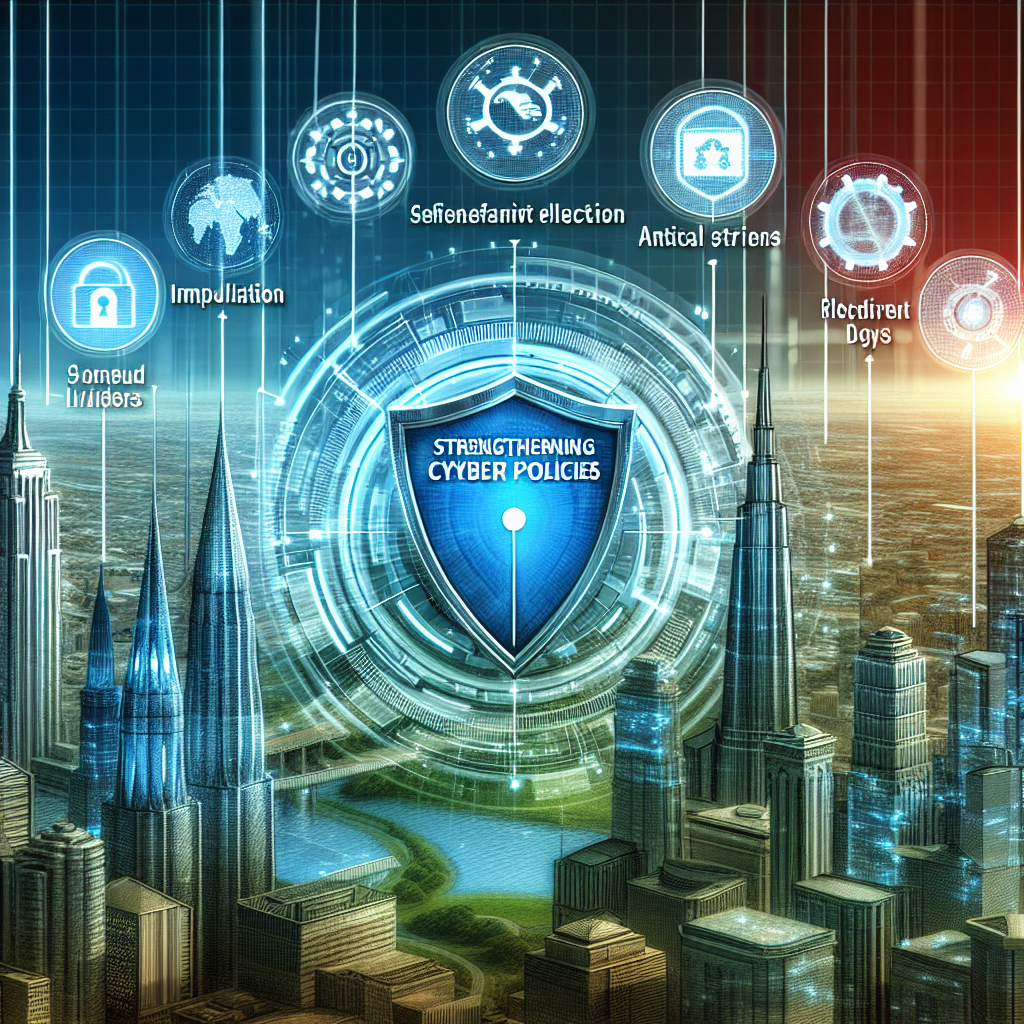Divergent Cyber Policies Emerge as Presidential Election Nears

As the presidential election approaches, the spotlight is increasingly focused on the candidates’ stances on various issues, with cybersecurity emerging as a critical area of concern. The digital landscape is rapidly evolving, and with it, the threats and challenges that nations face. This article delves into the divergent cyber policies proposed by the leading candidates, examining their implications for national security, economic stability, and individual privacy. Through a detailed exploration of five key subtopics, we aim to provide a comprehensive understanding of the cyber policy landscape as it stands on the brink of potential transformation.
1. The Current Cybersecurity Landscape
The cybersecurity landscape is a complex and ever-changing environment, shaped by technological advancements, geopolitical tensions, and evolving threat vectors. Understanding the current state of cybersecurity is essential to grasp the significance of the policies proposed by presidential candidates.
1.1 The Rise of Cyber Threats
In recent years, cyber threats have become more sophisticated and pervasive. From ransomware attacks targeting critical infrastructure to state-sponsored cyber espionage, the range of threats is vast and varied. According to a report by Cybersecurity Ventures, global cybercrime costs are expected to reach $10.5 trillion annually by 2025, highlighting the urgent need for robust cybersecurity measures.
One notable example is the 2021 Colonial Pipeline ransomware attack, which disrupted fuel supplies across the Eastern United States. This incident underscored the vulnerability of critical infrastructure to cyberattacks and prompted calls for enhanced cybersecurity protocols.
1.2 Geopolitical Tensions and Cyber Warfare
Geopolitical tensions have increasingly spilled over into the cyber realm, with nation-states engaging in cyber warfare to achieve strategic objectives. The United States, Russia, China, and other major powers are locked in a digital arms race, investing heavily in offensive and defensive cyber capabilities.
The SolarWinds cyberattack, attributed to Russian state actors, is a prime example of how cyber warfare can compromise national security. This attack infiltrated numerous U.S. government agencies and private companies, exposing sensitive data and raising concerns about the adequacy of existing cybersecurity measures.
1.3 The Role of Emerging Technologies
Emerging technologies such as artificial intelligence (AI), the Internet of Things (IoT), and 5G networks present both opportunities and challenges for cybersecurity. While these technologies offer enhanced capabilities, they also introduce new vulnerabilities that can be exploited by malicious actors.
For instance, the proliferation of IoT devices has expanded the attack surface for cybercriminals, as many of these devices lack robust security features. Similarly, the deployment of 5G networks has raised concerns about potential espionage and data breaches, prompting calls for stringent security standards.
1.4 Economic Implications of Cybersecurity
The economic impact of cybersecurity is significant, affecting businesses, governments, and individuals alike. Cyberattacks can result in financial losses, reputational damage, and legal liabilities, underscoring the need for comprehensive cybersecurity strategies.
According to a study by Accenture, the average cost of a cyberattack for a U.S. company is $13 million, with the financial sector being particularly vulnerable. This highlights the importance of investing in cybersecurity measures to protect economic interests and maintain consumer trust.
1.5 The Human Element in Cybersecurity
While technology plays a crucial role in cybersecurity, the human element cannot be overlooked. Human error, insider threats, and social engineering attacks are common vectors for cyber incidents, emphasizing the need for cybersecurity awareness and training.
Organizations are increasingly recognizing the importance of fostering a cybersecurity culture, with initiatives such as regular training sessions, phishing simulations, and employee engagement programs. By addressing the human element, organizations can enhance their overall cybersecurity posture.
2. Divergent Cyber Policies: A Comparative Analysis
As the presidential election draws near, candidates are unveiling their cyber policies, each offering a distinct vision for addressing the challenges of the digital age. This section provides a comparative analysis of the leading candidates’ cyber policies, highlighting their key differences and potential implications.
2.1 Candidate A: A Focus on National Security
Candidate A’s cyber policy is heavily focused on national security, emphasizing the need to protect critical infrastructure and bolster defense capabilities. This approach is rooted in the belief that a strong national defense is essential to safeguarding the nation’s digital assets.
- Increased funding for cybersecurity initiatives within the Department of Defense.
- Strengthening public-private partnerships to enhance information sharing and threat intelligence.
- Implementing stricter regulations for critical infrastructure sectors, such as energy and transportation.
Candidate A’s policy also includes a commitment to developing offensive cyber capabilities to deter potential adversaries. This approach has sparked debate, with some experts arguing that it could escalate tensions and lead to a cyber arms race.
2.2 Candidate B: Prioritizing Privacy and Civil Liberties
In contrast, Candidate B’s cyber policy prioritizes privacy and civil liberties, advocating for stronger data protection measures and greater transparency in government surveillance activities. This approach reflects a commitment to balancing security with individual rights.
- Enacting comprehensive data privacy legislation to protect consumer information.
- Reforming surveillance programs to ensure accountability and oversight.
- Promoting encryption and other privacy-enhancing technologies.
Candidate B’s policy has been praised by privacy advocates but criticized by some security experts who argue that it could hinder law enforcement efforts to combat cybercrime and terrorism.
2.3 Candidate C: Emphasizing Economic Competitiveness
Candidate C’s cyber policy is centered on economic competitiveness, with a focus on fostering innovation and supporting the growth of the technology sector. This approach aims to position the nation as a global leader in cybersecurity and digital innovation.
- Investing in research and development to drive technological advancements.
- Providing incentives for businesses to adopt cutting-edge cybersecurity solutions.
- Enhancing workforce development programs to address the cybersecurity skills gap.
While Candidate C’s policy has been lauded for its emphasis on economic growth, critics argue that it may not adequately address the immediate security threats facing the nation.
2.4 Candidate D: A Holistic Approach to Cybersecurity
Candidate D advocates for a holistic approach to cybersecurity, integrating elements of national security, privacy, and economic competitiveness. This policy seeks to address the multifaceted nature of cybersecurity challenges through a comprehensive strategy.
- Establishing a national cybersecurity task force to coordinate efforts across sectors.
- Implementing a risk-based approach to cybersecurity regulation.
- Promoting international cooperation to combat cyber threats.
Candidate D’s policy has been praised for its balanced approach, but some critics argue that it may lack the specificity needed to address certain issues effectively.
2.5 The Role of Partisan Politics in Cyber Policy
The divergent cyber policies proposed by the candidates reflect broader partisan divides, with each party prioritizing different aspects of cybersecurity. These differences are often rooted in ideological beliefs about the role of government, individual rights, and economic priorities.
As the election approaches, these partisan divides are likely to shape the national discourse on cybersecurity, influencing public opinion and potentially impacting the outcome of the election.
3. Case Studies: Cyber Policy in Action
To better understand the potential impact of the candidates’ cyber policies, it is helpful to examine case studies of past cyber policy initiatives. These case studies provide valuable insights into the challenges and successes of implementing cybersecurity measures at the national level.
3.1 The Obama Administration’s Cybersecurity Framework
In 2014, the Obama administration introduced the National Institute of Standards and Technology (NIST) Cybersecurity Framework, a voluntary set of guidelines designed to help organizations manage and reduce cybersecurity risks. This framework has been widely adopted by both public and private sector entities and is considered a significant achievement in U.S. cybersecurity policy.
The framework’s success can be attributed to its collaborative development process, which involved input from industry stakeholders, government agencies, and cybersecurity experts. This inclusive approach ensured that the framework was practical, flexible, and adaptable to different organizational needs.
3.2 The Trump Administration’s Cybersecurity Strategy
The Trump administration’s cybersecurity strategy, released in 2018, focused on protecting the American people, the homeland, and the American way of life. The strategy emphasized the importance of deterring adversaries, securing critical infrastructure, and promoting American prosperity through cybersecurity innovation.
One notable aspect of the strategy was its emphasis on offensive cyber capabilities, with the administration taking a more aggressive stance on cyber deterrence. This approach was met with mixed reactions, with some experts praising its boldness while others expressed concerns about potential escalation.
3.3 The European Union’s General Data Protection Regulation (GDPR)
The European Union’s General Data Protection Regulation (GDPR), implemented in 2018, is a landmark piece of legislation that has had a significant impact on global data privacy practices. The GDPR sets strict standards for data protection and privacy, with hefty fines for non-compliance.
The GDPR has been praised for its comprehensive approach to data privacy, but it has also faced criticism for its complexity and the burden it places on businesses. Nevertheless, it has set a global benchmark for data protection and has influenced privacy legislation in other countries.
3.4 The United Kingdom’s National Cyber Security Strategy
The United Kingdom’s National Cyber Security Strategy, launched in 2016, aims to make the UK the safest place to live and work online. The strategy focuses on three key objectives: defending the nation against cyber threats, deterring adversaries, and developing a resilient digital economy.
The UK’s approach includes the establishment of the National Cyber Security Centre (NCSC), which provides guidance and support to organizations in managing cyber risks. The NCSC has been instrumental in enhancing the UK’s cybersecurity posture and fostering collaboration between government and industry.
3.5 Lessons Learned from Past Cyber Policy Initiatives
These case studies highlight several key lessons for future cyber policy initiatives:
- The importance of collaboration and stakeholder engagement in policy development.
- The need for a balanced approach that addresses security, privacy, and economic considerations.
- The value of flexibility and adaptability in policy implementation.
- The potential benefits and challenges of international cooperation in cybersecurity.
By learning from past experiences, policymakers can develop more effective and comprehensive cyber policies that address the evolving challenges of the digital age.
4. The Impact of Cyber Policies on National Security
Cyber policies play a crucial role in shaping national security strategies, as they determine how a nation defends itself against cyber threats and protects its critical infrastructure. This section explores the impact of cyber policies on national security, examining key considerations and potential challenges.
4.1 Protecting Critical Infrastructure
Critical infrastructure, such as energy grids, transportation systems, and financial networks, is essential to the functioning of modern society. Cyber policies must prioritize the protection of these assets to ensure national security and economic stability.
One approach to protecting critical infrastructure is the implementation of sector-specific cybersecurity regulations, which set minimum security standards for key industries. These regulations can help mitigate risks and enhance resilience against cyberattacks.
4.2 Cyber Deterrence and Defense
Cyber deterrence involves dissuading adversaries from launching cyberattacks by demonstrating the capability and willingness to respond effectively. This can be achieved through a combination of defensive measures, offensive capabilities, and diplomatic efforts.
Defensive measures include strengthening network security, enhancing threat intelligence, and improving incident response capabilities. Offensive capabilities, such as cyber counterattacks, can serve as a deterrent by imposing costs on adversaries.
4.3 The Role of International Cooperation
Cyber threats are inherently global in nature, transcending national borders and requiring international cooperation to address effectively. Cyber policies must promote collaboration with allies and partners to share information, coordinate responses, and develop joint strategies.
International cooperation can take various forms, including bilateral agreements, multilateral forums, and participation in international organizations such as the United Nations and NATO. These efforts can enhance collective security and build trust among nations.
4.4 Balancing Security and Civil Liberties
While national security is a top priority, cyber policies must also respect civil liberties and individual rights. Striking the right balance between security and privacy is a complex challenge that requires careful consideration and transparent decision-making.
Policies that prioritize security at the expense of privacy can erode public trust and undermine democratic values. Conversely, policies that overly emphasize privacy may hinder law enforcement efforts and leave the nation vulnerable to cyber threats.
4.5 The Evolving Nature of Cyber Threats
The cyber threat landscape is constantly evolving, with new technologies and tactics emerging regularly. Cyber policies must be adaptable and forward-looking to address these dynamic challenges effectively.
This requires continuous monitoring of emerging threats, investment in research and development, and the cultivation of a skilled cybersecurity workforce. By staying ahead of the curve, nations can better protect themselves against future cyber threats.
5. The Future of Cyber Policy: Challenges and Opportunities
As the digital landscape continues to evolve, the future of cyber policy will be shaped by a range of challenges and opportunities. This section explores key trends and considerations that will influence the development of cyber policies in the coming years.
5.1 The Growing Importance of Cyber Resilience
Cyber resilience refers to the ability of an organization or nation to withstand and recover from cyber incidents. As cyber threats become more sophisticated, building resilience will be a critical focus of future cyber policies.
This involves not only implementing robust security measures but also developing comprehensive incident response plans, conducting regular exercises, and fostering a culture of resilience across all levels of society.
5.2 The Role of Artificial Intelligence in Cybersecurity
Artificial intelligence (AI) has the potential to revolutionize cybersecurity by enhancing threat detection, automating responses, and improving decision-making. However, AI also introduces new risks, such as the potential for adversaries to use AI-driven attacks.
Future cyber policies will need to address the dual role of AI in cybersecurity, promoting its benefits while mitigating its risks. This may involve developing ethical guidelines for AI use and investing in AI research and development.
5.3 The Challenge of Regulating Emerging Technologies
Emerging technologies, such as blockchain, quantum computing, and 5G networks, present both opportunities and challenges for cybersecurity. Regulating these technologies will be a complex task, requiring a nuanced understanding of their implications.
Future cyber policies will need to strike a balance between fostering innovation and ensuring security. This may involve developing flexible regulatory frameworks that can adapt to technological advancements.
5.4 The Importance of Public-Private Partnerships
Public-private partnerships are essential for addressing cybersecurity challenges, as they facilitate information sharing, resource pooling, and collaborative problem-solving. Future cyber policies will need to strengthen these partnerships to enhance collective security.
This may involve creating incentives for private sector participation, establishing clear communication channels, and fostering a culture of trust and collaboration between government and industry.
5.5 The Need for Global Cyber Governance
As cyber threats transcend national borders, there is a growing need for global cyber governance to coordinate efforts and establish common standards. Future cyber policies will need to promote international cooperation and dialogue to address this challenge.
This may involve participating in international forums, developing multilateral agreements, and supporting initiatives that promote global cybersecurity norms and best practices.
Conclusion
As the presidential election approaches, divergent cyber policies are emerging as a key area of focus for candidates and voters alike. These policies reflect differing priorities and visions for addressing the complex challenges of the digital age, with implications for national security, economic stability, and individual privacy.
By examining the current cybersecurity landscape, analyzing the candidates’ proposed policies, and exploring case studies of past initiatives, we gain valuable insights into the potential impact of these policies on the nation’s future. As we look ahead, it is clear that the development of effective and comprehensive cyber policies will be essential to navigating the evolving digital landscape and ensuring a secure and prosperous future for all.





